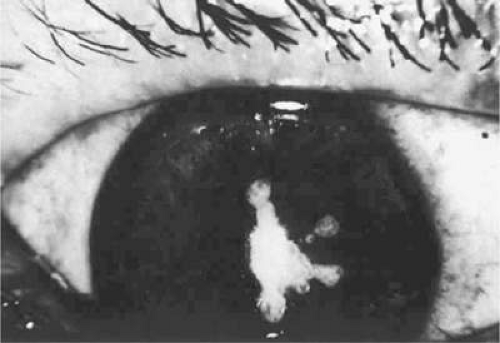Immunology of Skin Diseases That Affect the Eye
Mitchell H. Friedlaender
The skin of the eyelids is susceptible to the same types of hypersensitivity that affect the skin of other parts of the body. The lids are, in fact, peculiarly subject to inflammation. Because the eyelid skin is thinner than any other, it is unusually sensitive to trauma, to penetration by allergens, and to toxic substances. The loose subcutaneous tissues permit an accumulation of fluid that becomes walled off from the surrounding structures by the orbital septum, and that causes severe periorbital edema.
In this chapter, the 12 principal hypersensitivity diseases, or types of disease, that affect both skin and eye are discussed.
ATOPIC DERMATITIS
Atopic dermatitis is one of the eczematous skin eruptions (Fig. 29-1). It occurs most commonly but not exclusively in childhood. An incidence of 3% has been estimated in children younger than 5 years. Patients with atopic dermatitis often have a history of respiratory allergy or of allergic reactions to certain foods. In addition to other immunologic abnormalities, these patients seem to have skins that are abnormally reactive to various stimuli. This abnormal skin reactivity (probably a metabolic or biochemical defect) may be genetically determined. Although patients with atopic dermatitis undergo extensive allergic testing, it is often impossible to find any relationship between their dermatitis and a known allergen.
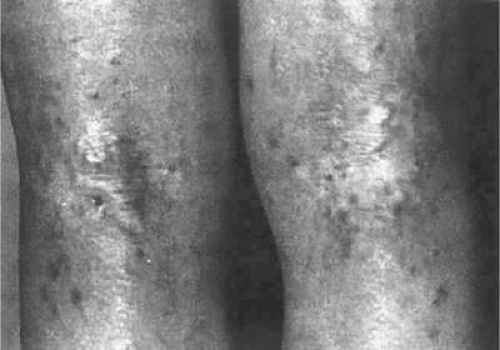 Figure 29.1. Skin lesions in atopic dermatitis. (Reproduced with permission from Korting G: The Skin and Eye. Philadelphia: WB Saunders, 1973.) |
Ocular findings include a chronic keratoconjunctivitis with papillary hypertrophy of the palpebral conjunctiva (Fig. 29-2). Atopic cataracts (Fig. 29-3) are sometimes observed and are typically shieldlike opacities located in the anterior portion of the lens. In contrast to vernal conjunctivitis, stellate or linear scarring of the conjunctiva may often be seen. An increased incidence of keratoconus is also associated with atopic keratoconjunctivitis. Tear film abnormalities and ocular surface disease have been reported.1
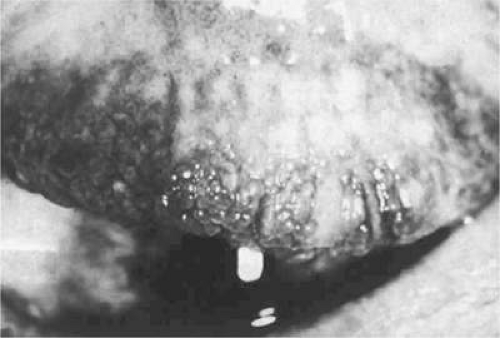 Figure 29.2. Atopic keratoconjunctivitis with papillary response of the upper palpebral conjunctiva. (Courtesy of Dr. HB Ostler.) |
IMMUNOPATHOLOGY
The following abnormal and paradoxic skin responses are characteristic of patients with atopic dermatitis.2
White Dermographism
When normal skin is stroked with a blunt instrument, the normal response is the erythema and wheal that characterize the triple response of Lewis. In patients with atopic dermatitis (and various other skin conditions), the erythema is often replaced by a white line surrounded by an area of blanching.
The Delayed-Blanch Phenomenon
When acetylcholine or methacholine is injected into the skin of normal individuals, vasodilation and erythema follow, but in patients with atopic dermatitis a white, spreading reaction occurs from 5 to 35 minutes after the injection and persists for as long as 60 minutes. This blanching in atopy was originally thought to be owing to a paradoxic vasoconstriction.3 It is now believed, however, that vasodilation does occur and that the erythema is obscured by an outpouring of fluid into the skin. It is this exudation of serum from capillaries that is unique in atopic patients.4
Norepinephrine Levels
Patients with atopic dermatitis have lower than normal levels of norepinephrine in the blood and higher than normal levels in affected skin.5 There is some indication that atopic patients have a tendency to bind large concentrations of norepinephrine to the skin. They also have cold hands and pallor of the ears, nose, and perioral area.
Immunoglobulin Levels
Serum IgE concentrations are usually elevated in patients with active atopic dermatitis and decline strikingly when the clinical manifestations of the disease are in remission.6,7 High IgG and low serum complement levels have been noted in some cases, but they may have been the result of the chronic skin infections that often develop in patients with atopic dermatitis. In most cases the serum levels of IgA, IgM, and IgD are normal. Recently, reduced amounts of secretory component have been noted in tears of patients with atopic dermatitis. This may explain the abnormal bacterial flora and susceptibility to infections that is sometimes seen.8 Despite the elevation of serum IgE, most atopic patients have normal numbers of peripheral blood lymphocytes carrying IgE and other immunoglobulins.96 They may have an abnormally high number of peripheral eosinophils and B lymphocytes, however, and of lymphocytes with complement receptors.
Levels of Cellular Immunity
Evidence that patients with atopic dermatitis are deficient in cellular immunity has been uncovered. Delayed hypersensitivity skin responses to ubiquitous antigens, including Candida and streptokinase-streptodornase, are often poor.9 This form of delayed cutaneous anergy is most marked in children with severe dermatitis. Such patients may also fail to become sensitized to the topical application of dinitrochlorobenzene. The mean percentages of T cells in the peripheral blood of patients with eczema may be lower than in normal controls, and the T-lymphocyte response to low concentrations of the mitogen phytohemagglutinin may be significantly depressed.10 Perhaps it is because of a defect in their cellular immunity that atopic patients have a higher than normal susceptibility to viral and fungal infections.11,12 Atopic patients also seem to have a high incidence of staphylococcal lid disease and herpetic keratitis. Various defects in the innate immune system have been identified, including a reduction of antimicrobial peptides, diminished recruitment of innate immune cells to the skin, epithelial barrier disruption.13,14
A further association between atopy and deficiencies in cellular immunity is suggested by certain well-studied immunodeficiency syndromes. Patients with Wiskott-Aldrich syndrome, ataxia-telangiectasia, and sex-linked hypogammaglobulinemia all have a form of eczema that is indistinguishable from atopic dermatitis.
Because T lymphocytes are important regulators of the synthesis of IgE and other antibodies, it has been postulated that a disorder of T-regulator cells is responsible for the failure of the cells to terminate IgE antibody response to certain antigens. IgE binds to mast cells in the skin, initiating the release of histamine and other chemical mediators during antigenic stimulation. The overly reactive skin of atopic patients may respond excessively to the effects of histamine and other chemical mediators.
It is now clear that cytokines play a key role in regulating antibody synthesis. Interleukin-4 seems to be particularly important in human IgE synthesis and may have an important role in controlling mast cells and IgE production in atopic dermatitis.15
Eosinophil activation and cell surface antigen expression are greater in atopic keratoconjunctivitis than in less inflammatory ocular allergic disorders.16
HISTOLOGY
Atopic dermatitis lesions show interepithelial vesicles, vascular dilation in the dermis, and perivascular infiltration by inflammatory cells. Chronic lesions also show hyperkeratosis and acanthosis. Lysosomes have been found in the stratum granulosum of atopic skin by electron microscopy, suggesting the possibility that the disease has an autodigestive component. The corneal disease in atopic keratoconjunctivitis has recently been studied by confocal microscopy and shows significant alterations in the basal epithelium and corneal nerves IIf. Hyperplasia of mast cells has been noted in the conjunctival epithelium and stroma.17 Strong staining for HLA-DR antigens has been found in the conjunctival epithelium.18
CONTACT DERMATITIS
Contact dermatitis is probably the most common immunologic disease encountered by dermatologists. It results from the exposure of the skin to many substances commonly found in the environment. These include drugs, dyes, plant resins, preservatives, cosmetics, and metals. There are two types of contact dermatitis: irritant (the more common type) and allergic. Irritant contact dermatitis is caused by damage to the skin from excessive moisture or from acids, alkalis, resins, or chemicals capable of injuring the skin if in contact with it long enough. Neither allergy nor hypersensitivity plays a role in irritant contact dermatitis. In contrast, allergic contact dermatitis occurs only in sensitized individuals, and the mechanism of cell-mediated immunity is brought into play. When an individual who has been sensitized to a given chemical or other sensitizing substance is re-exposed to the same chemical, an erythematous, delayed skin reaction is induced. Contact sensitivity affecting the eyelids is often owing to topical ophthalmic preparations such as neomycin (Fig. 29-4) and atropine. Contact allergy to glaucoma drops, antibiotics, preservatives, cyanoacrylate, and latex have also been reported.19. Recently, contact dermatitis has been associated with the prostaglandin analogue, latanaprost.20 Eyeglass frames, soaps, and cosmetics may also be responsible for contact sensitivity around the eyes.
IMMUNOPATHOLOGY
Irritant dermatitis is provoked by frequent defatting of the skin by excessive moisture or by substances with highly irritant properties.21 Continued defatting or repeated irritant exposure is followed by edema, erythema, vesiculation, and scaling of the skin. While the eczematous skin is inflamed, it is in danger of developing a secondary allergic contact dermatitis. If the irritant is removed or if the habit that produced the inflammation is curtailed, the irritant dermatitis resolves.
In allergic contact dermatitis, the sensitizing substances are usually low-molecular-weight haptens that bind to dermal proteins and form complete antigens. The haptens do not significantly alter the configuration of these carrier proteins. When a contact sensitizer is first applied, most of it is rapidly removed by the bloodstream. Whether sensitization occurs in the draining lymph node, at a peripheral skin site, or elsewhere is not known for certain. It is known, however, that initial exposure results in the production of specifically sensitized lymphocytes capable of responding to the antigen when re-exposure occurs. A second application of the sensitizing substance produces an inflammatory response and an accumulation of mononuclear and other inflammatory cells characteristics of cell-mediated responses.
In the guinea pig, contact sensitivity can be transferred to unsensitized guinea pigs with mononuclear or lymph node cells. This was first shown in the classic experiments of Landsteiner and Chase22 in 1942. The chemical substances that mediate these erythematous reactions may be the lymphokines that are produced by sensitized lymphocytes on exposure to a specific antigen. The role of the prostaglandins in allergic contact dermatitis has also been studied with interest. Prostaglandin E can induce delayed-onset inflammation and a dusky erythema of the skin that persists for up to 10 hours.
The lesions of allergic contact dermatitis do not depend on humoral antibody and do not spare individuals with deficiencies of the humoral immune system. Patients with cell-mediated immune deficiencies, however, have little or no contact sensitivity. These are patients with certain malignancies, sarcoidosis, and certain immunodeficiency diseases such as the Wiskott-Aldrich syndrome. Langerhans cells of the epidermis appear to trap contact allergens. These cells then interact with T lymphocytes to establish contact sensitivity.
HISTOLOGY
The lesions of contact dermatitis are characterized by mononuclear cell infiltration of the dermis. During the acute stages, the epidermis shows edema or spongiosis followed by intraepidermal vesiculation. During the chronic stages there may be irregular epidermal thickening and hyperkeratosis. Dvorak and Dvorak23,24 showed that contact dermatitis lesions in guinea pigs and humans contain large infiltrations of basophilic leukocytes.
URTICARIA
Urticaria is a cutaneous eruption induced by various immunologic and nonimmunologic pathogenic mechanisms.25,26 Its prevalence in the general population is high (between 10% and 25%). In 70% to 90% of cases, no specific cause can be found; in the other 10% to 30%, psychogenic, allergic, and physical factors can be identified. An etiologic classification of urticaria is presented in Table 1. The skin lesions are sharply circumscribed elevated areas of edema and may occur around the eyes (Fig. 29-5). If the swelling is extensive and affects the subcutaneous tissues, the term angioedema is used to describe it. Urticaria can be classified as acute or chronic. Acute urticaria is often associated with immunologic mechanisms; chronic urticaria, which lasts 8 weeks and more, often has no identifiable cause, although emotional or allergic factors are sometimes implicated.
TABLE 29-1. Causes of Chronic Urticarial Lesions | |||||||||||||||||||||||||||||
|---|---|---|---|---|---|---|---|---|---|---|---|---|---|---|---|---|---|---|---|---|---|---|---|---|---|---|---|---|---|
|
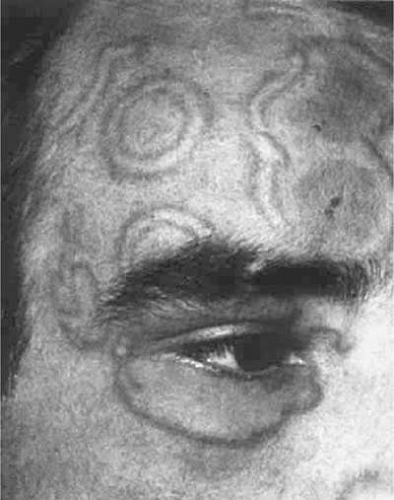 Figure 29.5. Urticaria. (Reproduced with permission from Korting G: The Skin and Eye. Philadelphia: WB Saunders, 1973.) |
IMMUNOPATHOLOGY
The clinical signs of urticaria can be simulated by injecting histamine into the skin. This results in localized vasodilation, increased vascular permeability, and itching. Except in cold urticaria, however, the plasma histamine level is not elevated. This may be owing to the normally rapid uptake of histamine by various tissues.27
The immunologic mechanisms in urticaria are not well understood. Cell-bound IgE is not increased, and serum IgE levels, although sometimes elevated, are often within normal limits.28 Occasionally, depressed levels of IgG, IgA, and IgM are found in children with both chronic urticaria and chronic infection.29
Urticaria may be associated with type II (cytotoxic) hypersensitivity reactions. This is the mechanism that plays a role in hemolytic transfusion reactions when IgG or IgM antibodies react with erythrocyte antigens and induce cell lysis. Urticaria may occur during serum sickness or in response to a drug allergy such as allergy to penicillin. Most of the immunologic causes of urticaria are related to infection, foods, and drugs.
When IgE antibody is not concerned in the urticarial reaction, cytotoxic mechanisms and immune (antigen-antibody) complexes often play a role. Activation of the complement system and production of the anaphylatoxins C3a and C5a may lead to histamine release from mast cells. Clinical examples of urticaria caused by immune-complex deposition are seen in serum sickness and cryoglobulinemia (cold urticaria). In human serum sickness, IgE reaginic antibodies are believed to mediate the urticarial lesions, whereas antigen-antibody complexes mediate the lesions of the heart, kidneys, and joints. Cold urticaria may be passively transferred to normal recipients with cold precipitable IgG. Although this event is normally attributed to aggregated IgG or mixed IgG-IgM cryoglobulins and activation of the complement system, it is possible that homocytotropic IgG antibodies also play a part.
Histamine is believed to be the principal mediator in urticaria, but its duration of action is thought to be too short to account for all the observed clinical manifestations. The precise role of other possible mediators such as slow-reacting substance of anaphylaxis, bradykinin, and the prostaglandins has yet to be established.
HISTOLOGY
Urticarial lesions are infiltrated by neutrophils and eosinophils, and dermal edema and vasodilation are prominent features. In chronic urticaria, electron microscopy has also shown a reduction in the density of mast cell granules.
HEREDITARY ANGIOEDEMA
Hereditary angioedema is characterized by repeated attacks of subepithelial edema affecting the skin, the respiratory tract, and the gastrointestinal tract. Lid edema is sometimes a prominent feature (Fig. 29-6). The skin lesions may be well demarcated, but there is no urticaria. Although hereditary angioedema was recognized in 1888, it is only recently that a biochemical abnormality in the complement system was found to be associated with it.30,31,32,33
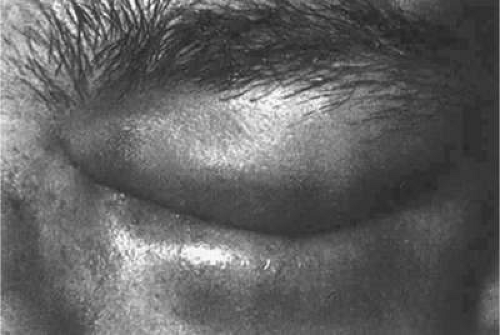 Figure 29.6. Angioneurotic edema. (Reproduced with permission from Korting G: The Skin and Eye. Philadelphia: WB Saunders, 1973.) |
IMMUNOPATHOLOGY
Patients with hereditary angioedema have an inherited deficiency of C1 inhibitor, an α2-globulin that inhibits activation of the first component of complement. This leads to uncontrolled activation of the complement pathway; to the generation of a kininlike substance; and to repeated episodes of angioedema affecting the skin, the respiratory tract, and the gastrointestinal tract. Pharyngeal or laryngeal edema may cause asphyxiation and death. In 85% of the patient’s relatives, C1 inhibitor is deficient or absent. In the remaining 15%, the inhibitor is present in normal amounts but is functionally inactive.
C1 inhibitor acts in two places during the activation of C1. It inhibits mainly C1s but may also inhibit C1r.34 C1 inhibitor has many other physiologic functions and is known to inhibit the kinin system, plasma thromboplastin antecedent (factor XI), plasmin, and activated Hageman factor. These other functions may contribute to the role of C1 inhibitor in the manifestations of hereditary angioedema. The administration of C1-esterase inhibitor either in fresh-frozen plasma or in partially purified form has been useful in terminating acute attacks of the disease. Inhibitors of plasmin such as ε-aminocaproic acid and tranexamic acid have been effective when given prophylactically. Purified C1-esterase inhibitor is now available, and its effects last about 3 days.35
PSORIASIS
Psoriasis is a chronic skin disease characterized by epidermal hyperplasia and an accelerated rate of epidermal turnover. Although it is inherited as a simple autosomal dominant trait with incomplete penetrance, both genetic and environmental factors are important. Aside from the scaling, erythematous skin lesions, the disease is often associated with inflammatory arthritis. Ocular changes—lid lesions, conjunctival lesions, and corneal vascularization—are reported to occur in 10% of affected patients (Fig. 29-7). Meibomian gland dysfunction has been observed, and may be related to increased turnover of the epithelial cells lining the meibomian gland ducts.36 Peripheral corneal infiltrates are sometimes seen, and acute anterior uveitis is occasionally observed in psoriatic patients who possess the histocompatibility antigen HLA-B27. These changes are twice as frequent in males than in females and may be the only manifestations of the disease.37
 Figure 29.7. Nonspecific conjunctivitis associated with psoriasis. The skin is scaly and erythematous. (Courtesy of Dr. HB Ostler.) |
IMMUNOPATHOLOGY
Psoriatic patients have a threefold to fourfold greater than normal number of the histocompatibility antigens HLA-B13 and HLA-B17.38,39 In one third of the patients, especially those with concurrent arthritis, the IgM level is lower than normal.40 Studies have shown higher than normal levels of serum IgG, IgA, and IgE and higher than normal levels of salivary IgA in some patients.41 Anti-IgG antibodies have been found in 45% of patients with psoriasis, suggesting the possibility that the disease is an autoimmune disorder. Cell-mediated immunity may also be affected. It is difficult to induce hypersensitivity to chemical agents (e.g., dinitrochlorobenzene) in psoriatic patients, even in those not receiving immunosuppressive drugs, and the lymphocytes show a diminished response to mitogen phytohemagglutinin.42,43
Stay updated, free articles. Join our Telegram channel

Full access? Get Clinical Tree


